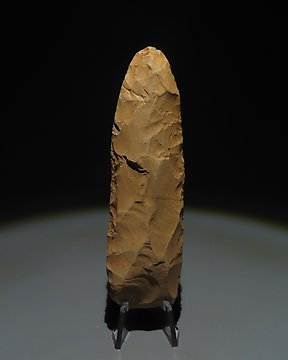
新石器时代 石头 工具。公元前 3000-2000 年。长 9.8 厘米。
编号 82144679

编号 82144679

Owl-Shaped Mace Head.
Guanacaste - Nicoya, Costa Rica, 1 - 1500 A.D.
Stone.
8.5 cm height and 9 cm length.
PROVENANCE: Private collection, Mézières-lez-Cléry, France. Acquired by inheritance in 2022.
DESCRIPTION:
Mace head carved in green stone in rounded bulk, representing the head of an owl with geometric features, of great expressiveness and formal elegance, strictly symmetrical in its composition. The large eyes, the most identifying element of the animal, stand out especially, worked with a soft concavity and outlined with a groove that ends on both sides of the beak, flat and pointed. The carving is topped by two cylindrical protuberances that allude to the feathers that crown the owl's head. The piece has a large vertical perforation, where the wooden shaft of the mallet would have been fixed.
The Great Nicoya is an archaeological region that includes the northwest of Costa Rica and the Pacific coast of Nicaragua. The Southern Subregion, or Guanacaste, occupies the Nicoya Peninsula, the Tempisque River basin and the Guanacaste and Tilarán mountain ranges. It is an area with human occupation since about 10,000 years ago, with important remains of material culture in ceramics, carved stone and jade from the Tempisque period (500-300 B.C.). In the Bagaces period (300-800 A.D.) there is already a complex social organization, although the real cultural peak of the region was developed in times of the Nicoya Kingdom, between the year 800 and the European conquest.
The carved mace heads of the Nicoya culture have their origin in the influences of the Andean Cultural Area, and represent one of the main manifestations of the artistic production in stone of this people. Despite their shape, these pieces were never used as a weapon, but rather fulfilled a symbolic function. The maces were wielded by monarchs as a representation of their authority, and by shamans during magic-religious rituals. They were carved representing human heads and skulls and also figures or heads of birds and other animals such as bats and coyotes. Globular mace heads have also been found, with or without protuberances. It has been interpreted that they could be the representation of family clan symbols.
BIBLIOGRAPHY:
- FERNÁNDEZ, P.; ALVARADO, G.E. Artesanos y Piedras: Herramientas y Escultura Precolombina en Costa Rica. Fundación Museos Banco Central de Costa Rica. 2006.
- FERRERO, L. Costa Rica precolombina: arqueología, etnología, tecnología, arte. Editorial Costa Rica. 2000.
PARALLELS:
Fig. 1 Owl-shaped mace head. Nicoya, Costa Rica, A.D. 1-1500, stone. Denver Art Museum (USA), inv. 1994.878.
Fig. 2 Owl-shaped mace head. Nicoya, Costa Rica, A.D. 300-500, stone. Michael C. Carlos Museum, Atlanta (USA), inv. 1994.018.050.
Fig. 3 Owl-shaped mace head. Nicoya, Costa Rica, A.D. 300-500, stone. Michael C. Carlos Museum, Atlanta (USA), inv. 2004.006.001.
Notes:
- The piece includes authenticity certificate.
- The piece includes Spanish Export License.
- The seller guarantees that he acquired this piece according to all national and international laws related to the ownership of cultural property. Provenance statement seen by Catawiki.